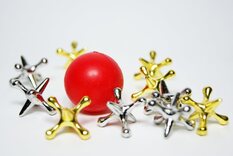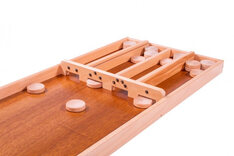The Rules of Fivestones and Jacks
Fivestones is a traditional children's game played the world over for which there is no formal organising body. Consequently, rules vary from country to country and place to place. The game is also known by a variety of names including Jackstones, Chuckstones, Dibs, Dabs, Fivestones, Otadama, Tally and Knucklebones. Jacks is a variant of Fivestones which uses a ball.
See also: Table-top Games.
Fivestones
Description of equipment
All that is needed to play the game of Fivestones is five small stones. Alternatives to the stones can be pretty much anything of a similar size - originally sheep knucklebones were used.
The Play
To start a turn, the player throws five stones into the air with one hand and tries to catch as many as possible on the back of the same hand. The stones that were caught are then thrown up again from the back of the hand where they came to rest and as many as possible are caught in the palm of the same hand. If no stones end up being caught, the player's turn is over.
If, however, at least one stone was caught, the player prepares for the next throw by keeping one of the caught stones in the same hand and throwing all remaining stones on the ground. The player then tosses the single stone into the air, attempts to pick up one of the stones that was missed and then catches the stone that was tossed, all with the same hand. The player repeats this until all the stones have been picked up.
That done, the player throws down four of the stones again, throws the single stone in the air, attempts to pick up two stones with the same hand before catching the tossed stone. This is repeated again and a final toss sees the player picking up the last stone. The process is then repeated for three stones followed by one stone and finally, all four stones are picked up before catching the single tossed stone.
For skilful players, the game can continue in an agreed way with further permutations and challenges according to the player's whims. For instance, the other hand could be used to throw, the player may have to clap hands before doing the pick up or perhaps slap both knees.
Jacks
Description of equipment
All that is needed to play the game of Jacks is five jacks and one ball. The jacks are just a more modern representation of knucklebones or stones from the game described above; each one is a six-pronged, metal form with bobbles on the end of each prong - a three-dimensional cross. The ball is bouncy and should be somewhat bigger than a jack.
The Play
To decide who starts, a player throws five jacks into the air with one hand and tries to catch as many as possible on the back of the same hand. The jacks that were caught are then thrown up again from the back of the hand where they came to rest and as many as possible are caught in the palm of the same hand. The other players do the same and the player who catches the most jacks starts, play continuing in a clockwise fashion. The first player prepares to start by throwing the five jacks on the ground and then picking up the the ball. The player throws the ball up, picks up one jack with the same hand and then catches the ball before it hits the ground. The jack is then put into the other hand. This is repeated until all the jacks have been picked up. The player then throws the jacks back on the floor and starts again, but this time, two jacks must be picked up each time except for the third and final throw when, obviously, only one jack is picked up. Once this is achieved successfully, the player starts again but this time with three jacks and then again with four jacks and finally the ball is thrown up and all five jacks are picked up at once before the ball is caught. When the player misses the ball or does not manage to pick up the requisite number of jacks, the turn immediately finishes and the next player has a try. The player who manages to prgress furthest in the sequence of throws wins.
Variations
Some people allow the ball to bounce one before it must be caught. This should make the game a little easier. Experts can experiment by continuing the play in the form of harder challenges. For instance, the ball might be bounced downwards instead of thrown upwards or a clap of the hands must be performed before the pick-up or perhaps the other hand must be used as a second round.
These rules are provided by Masters Traditional Games, an Internet shop selling quality traditional games, pub games and unusual games. For general information or for copying and copyright, see our Rules Information page.
Our rules are comprehensive instructions for friendly play. If in doubt, always abide by locally-played or house rules.
Copyright James Masters, 2025. All rights reserved.








































